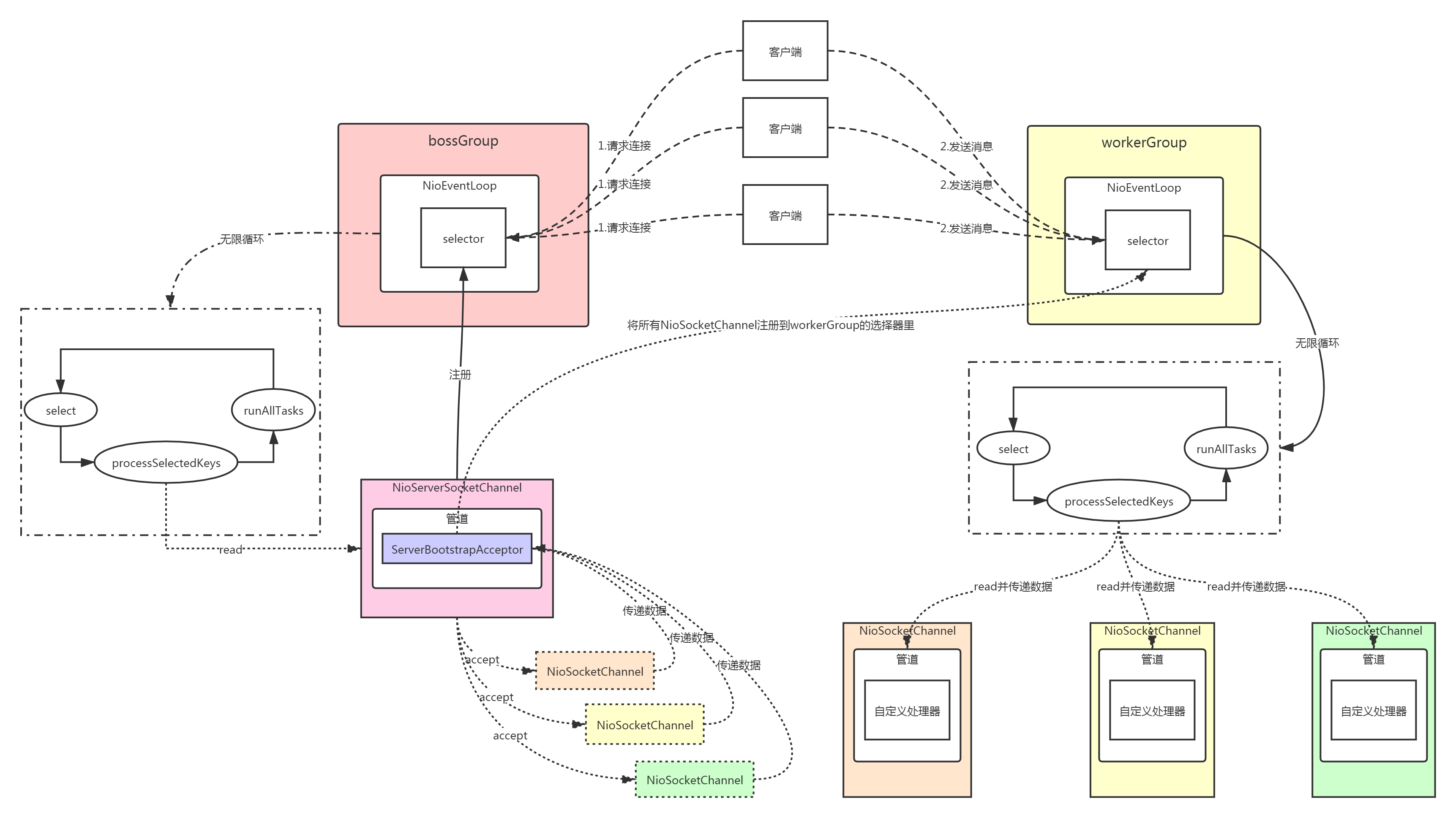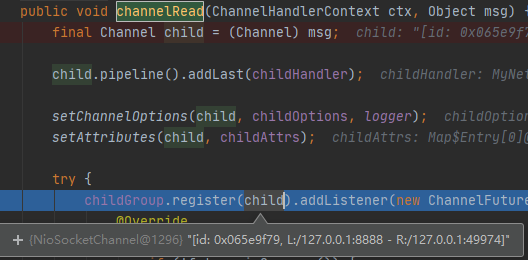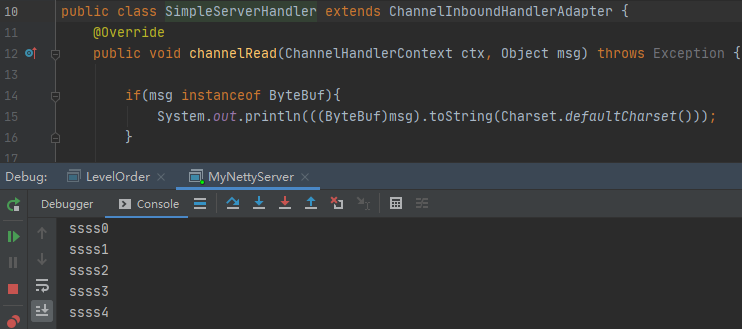workerGroup注册NioSocketChannel

书接上文,ServerBootstrapAcceptor的channelRead(ChannelHandlerContext ctx, Object msg)方法将NioSocketChannel注册到workerGroup。
public void channelRead(ChannelHandlerContext ctx, Object msg) { final Channel child = (Channel) msg; child.pipeline().addLast(childHandler); setChannelOptions(child, childOptions, logger); setAttributes(child, childAttrs); try { childGroup.register(child).addListener(new ChannelFutureListener() { @Override public void operationComplete(ChannelFuture future) throws Exception { if (!future.isSuccess()) { forceClose(child, future.cause()); } } }); } catch (Throwable t) { forceClose(child, t); } }
注册的是NioSocketChannel类型

而bossGroup注册的是NioServerSocketChannel

此参数是在NioServerSocketChannel的doReadMessages(List<Object> buf)方法中初始化。

childGroup.register(child)内部实现和bossGroup一样,也是从workerGroup中选一个NioEventLoop进行注册。
可看到workerGroup的线程已开启,2-1为bossGroup,3-1为workerGroup

然后就是workerGroup的线程执行注册任务,后续操作和bossGroup类似。注册选择器,执行pipeline.invokeHandlerAddedIfNeeded();方法,执行我们自定义的childHandler的handlerAdded方法,执行ChannelInitializer的initChannel方法,将我们自定义的处理器添加进去。然后执行相应的handlerAdded,channelRegistered,channelActive方法。完成任务之后,就进入select阻塞了。
读取消息
跟之前一样,接收到消息,调用processSelectedKeys等后续方法
public final void read() { final ChannelConfig config = config(); if (shouldBreakReadReady(config)) { clearReadPending(); return; } final ChannelPipeline pipeline = pipeline(); final ByteBufAllocator allocator = config.getAllocator();//字节缓冲区分配器 final RecvByteBufAllocator.Handle allocHandle = recvBufAllocHandle(); allocHandle.reset(config); ByteBuf byteBuf = null; boolean close = false; try { do { byteBuf = allocHandle.allocate(allocator); allocHandle.lastBytesRead(doReadBytes(byteBuf)); if (allocHandle.lastBytesRead() <= 0) { // nothing was read. release the buffer. byteBuf.release(); byteBuf = null; close = allocHandle.lastBytesRead() < 0; if (close) { // There is nothing left to read as we received an EOF. readPending = false; } break; } allocHandle.incMessagesRead(1); readPending = false; pipeline.fireChannelRead(byteBuf);//传递事件 byteBuf = null; } while (allocHandle.continueReading()); allocHandle.readComplete(); pipeline.fireChannelReadComplete(); if (close) { closeOnRead(pipeline); } } catch (Throwable t) { handleReadException(pipeline, byteBuf, t, close, allocHandle); } finally { // Check if there is a readPending which was not processed yet. // This could be for two reasons: // * The user called Channel.read() or ChannelHandlerContext.read() in channelRead(...) method // * The user called Channel.read() or ChannelHandlerContext.read() in channelReadComplete(...) method // // See https://github.com/netty/netty/issues/2254 if (!readPending && !config.isAutoRead()) { removeReadOp(); } } }
doReadBytes(byteBuf)
protected int doReadBytes(ByteBuf byteBuf) throws Exception { final RecvByteBufAllocator.Handle allocHandle = unsafe().recvBufAllocHandle();//获取分配处理器 allocHandle.attemptedBytesRead(byteBuf.writableBytes());//设置可写的字节 return byteBuf.writeBytes(javaChannel(), allocHandle.attemptedBytesRead());//读取通道的数据,写入字节缓冲区 }
writeBytes(ScatteringByteChannel in, int length) :向缓冲区写入数据
public int writeBytes(ScatteringByteChannel in, int length) throws IOException { ensureWritable(length); int writtenBytes = setBytes(writerIndex, in, length); if (writtenBytes > 0) { writerIndex += writtenBytes; } return writtenBytes; }
PooledByteBuf.setBytes(int index, ScatteringByteChannel in, int length)
in.read:通道从底层去读取socket缓冲区的数据到字节缓冲区里:
public final int setBytes(int index, ScatteringByteChannel in, int length) throws IOException { try { return in.read(internalNioBuffer(index, length)); } catch (ClosedChannelException ignored) { return -1; } }
PooledByteBuf.internalNioBuffer(int index, int length):返回ByteBuffer ,底层封装了ByteBuffer
public final ByteBuffer internalNioBuffer(int index, int length) { checkIndex(index, length); return _internalNioBuffer(index, length, false); }
_internalNioBuffer(int index, int length, boolean duplicate)
final ByteBuffer _internalNioBuffer(int index, int length, boolean duplicate) { index = idx(index); ByteBuffer buffer = duplicate ? newInternalNioBuffer(memory) : internalNioBuffer(); buffer.limit(index + length).position(index); return buffer; }
直接缓冲区DirectByteBuffer,少了一次从内核到用户空间的数据拷贝

pipeline.fireChannelRead(byteBuf);
把缓冲区数据传递到管道里,让处理器处理,传递到我自定义的处理器中,读取出来:

客户端:
